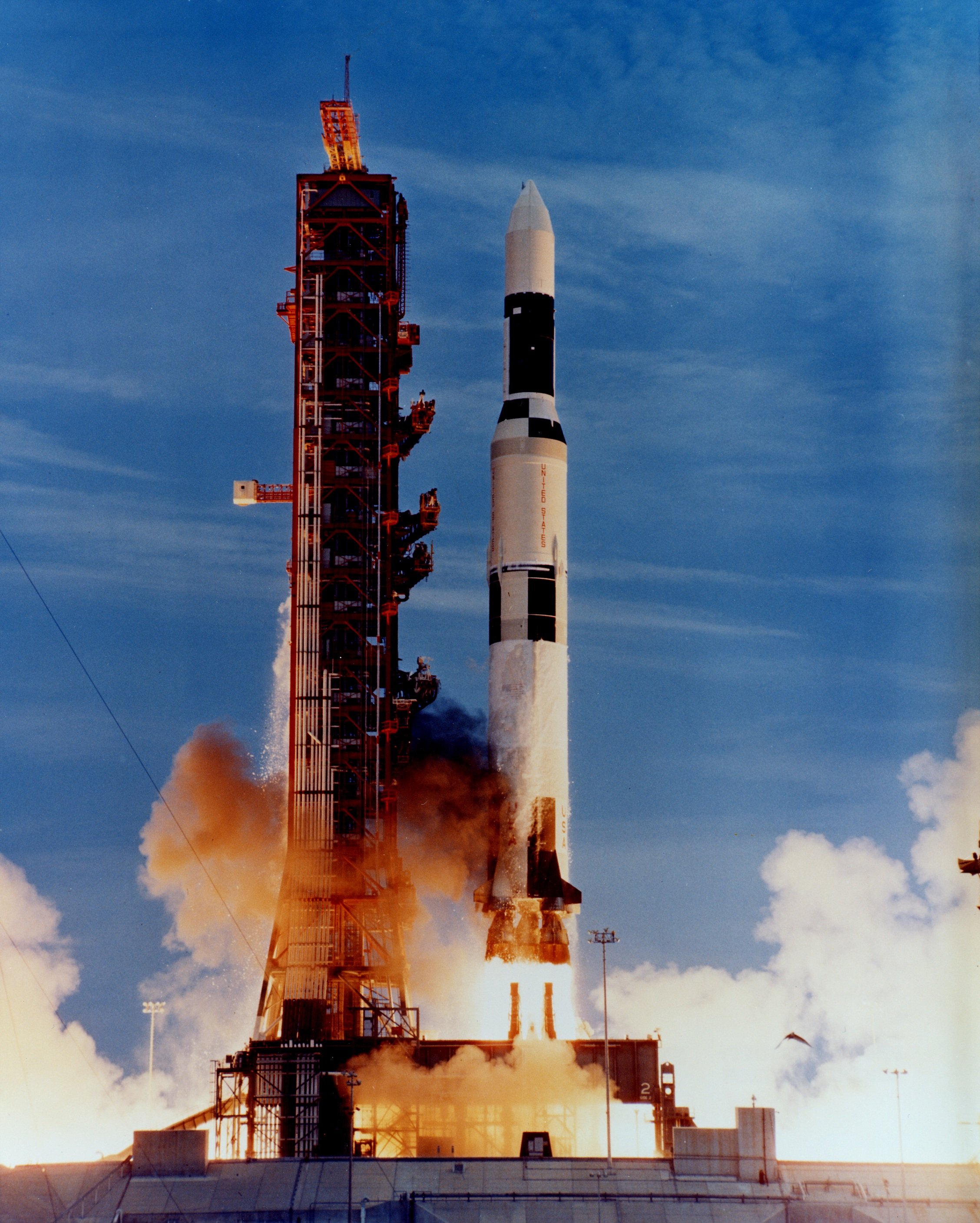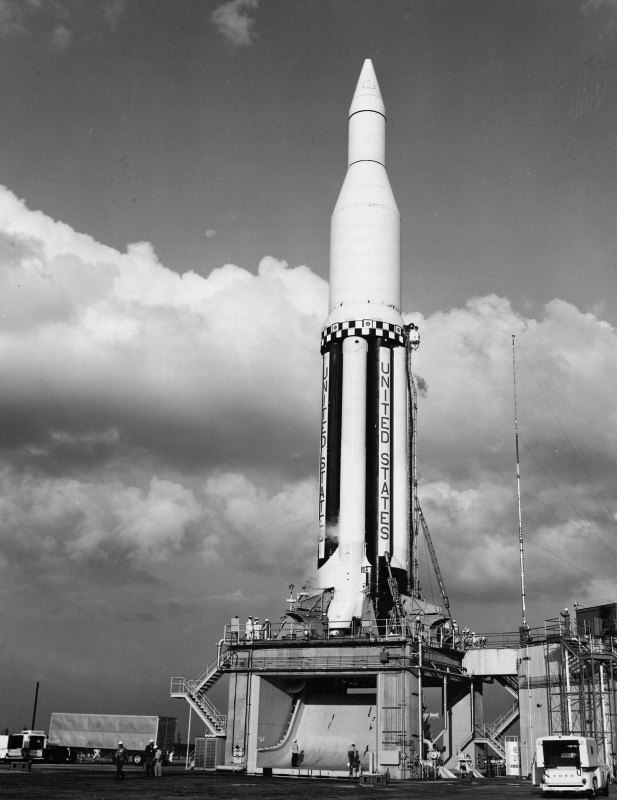|
Saturn INT-21
The Saturn INT-21 was a study for an American orbital launch vehicle of the 1970s. It was derived from the Saturn V rocket used for the Apollo program, using its first and second stages, but lacking the third stage. The guidance unit would be moved from the top of the third stage to the top of the second stage. The INT-21 was never flown. A related variant was launched once, from the Kennedy Space Center, Florida carrying the Skylab space station into orbit, at 17:30 UTC, on May 14, 1973. As ''Skylab'' was built from an S-IVB stage, there was no need to move the guidance unit. This version was intended to be used for other flights in the Apollo Applications Program, and would have also been used to launch other American space stations, including Skylab B. See also *Comparison of orbital launch systems * Apollo program *Saturn I * Saturn IB *Saturn V *Skylab *Apollo Applications Program The Apollo Applications Program (AAP) was created as early as 1966 by NASA headquarte ... [...More Info...] [...Related Items...] OR: [Wikipedia] [Google] [Baidu] |
Launch Vehicle
A launch vehicle or carrier rocket is a rocket designed to carry a payload (spacecraft or satellites) from the Earth's surface to outer space. Most launch vehicles operate from a launch pad, launch pads, supported by a missile launch control center, launch control center and systems such as vehicle assembly and fueling. Launch vehicles are engineered with advanced aerodynamics and technologies, which contribute to large operating costs. An orbital spaceflight, orbital launch vehicle must lift its payload at least to the boundary of space, approximately and accelerate it to a horizontal velocity of at least . Suborbital spaceflight, Suborbital vehicles launch their payloads to lower velocity or are launched at elevation angles greater than horizontal. Practical orbital launch vehicles are multistage rockets which use chemical propellants such as Solid-propellant rocket, solid fuel, liquid hydrogen, kerosene, liquid oxygen, or Hypergolic propellants. Launch vehicles are cla ... [...More Info...] [...Related Items...] OR: [Wikipedia] [Google] [Baidu] |
Saturn I SA-1
Saturn-Apollo 1 (SA-1) was the first flight of the Saturn I space launch vehicle, the first in the Saturn family, and first mission of the American Apollo program. The rocket was launched on October 27, 1961, from Cape Canaveral, Florida. Objectives The Saturn I booster was a huge increase in size and power over anything previously launched. It was three times taller, required six times more fuel and produced ten times more thrust than the Juno I rocket that had launched the first American satellite, '' Explorer 1'', into orbit in 1958. At the time, NASA had decided to not use all-up testing, when an entire system is tested at once. The agency planned to test each rocket stage in separate launches, so for SA-1 the only live stage was the S-I first stage. This first flight was designed to test the structure of the launch vehicle during a suborbital flight using the nose cone from a Jupiter rocket. Preparation As this was the first Saturn flight, the systems were still ... [...More Info...] [...Related Items...] OR: [Wikipedia] [Google] [Baidu] |
Saturn IB
The Saturn IB (also known as the uprated Saturn I) was an American launch vehicle commissioned by the NASA, National Aeronautics and Space Administration (NASA) for the Apollo program. It uprated the Saturn I by replacing the S-IV second stage (, 43,380,000 lb-sec total impulse), with the S-IVB (, 96,000,000 lb-sec total impulse). The S-IB first stage also increased the S-I baseline's thrust from to and propellant load by 3.1%. This increased the Saturn I's low Earth orbit payload capability from to , enough for early flight tests of a half-fueled Apollo command and service module (CSM) or a fully fueled Apollo Lunar Module (LM), before the larger Saturn V needed for lunar flight was ready. By sharing the S-IVB upper stage, the Saturn IB and Saturn V provided a common interface to the Apollo spacecraft. The only major difference was that the S-IVB on the Saturn V burned only part of its propellant to achieve Earth orbit, so it could be restarted for trans-lunar injec ... [...More Info...] [...Related Items...] OR: [Wikipedia] [Google] [Baidu] |
Saturn I
The Saturn I was a rocket designed as the United States' first medium lift launch vehicle for up to low Earth orbit payloads.Terminology has changed since the 1960s; back then, 20,000 pounds was considered "heavy lift". The rocket's first stage was built as a cluster of propellant tanks engineered from older rocket tank designs, leading critics to jokingly refer to it as "Cluster's Last Stand". Its development was taken over from the Advanced Research Projects Agency in 1958 by the newly formed civilian NASA. Its design proved sound and flexible. It was successful in initiating the development of liquid hydrogen-fueled rocket propulsion, launching the Pegasus satellites, and flight verification of the Apollo command and service module launch phase aerodynamics. Ten Saturn I rockets were flown before it was replaced by the heavy lift derivative Saturn IB, which used a larger, higher total impulse second stage and an improved guidance and control system. It also led the way to ... [...More Info...] [...Related Items...] OR: [Wikipedia] [Google] [Baidu] |
Comparison Of Orbital Launch Systems
This comparison of orbital launch systems lists the attributes of all individual rocket configurations designed to reach orbit. A first list contains rockets that are operational or in development as of 2022; a second list includes all retired rockets. For the simple list of all conventional launcher families, see: Comparison of orbital launchers families. For the list of predominantly solid-fueled orbital launch systems, see: Comparison of solid-fueled orbital launch systems. Spacecraft propulsionThere are many different methods. Each method has drawbacks and advantages, and spacecraft propulsion is an active area of research. However, most spacecraft today are propelled by forcing a gas from the back/rear of the vehicle at very high speed through a supersonic de Laval nozzle. This sort of engine is called a rocket engine. is any method used to accelerate spacecraft and artificial satellites. A conventional solid rocket or a conventional solid-fuel rocket is a rocket with a moto ... [...More Info...] [...Related Items...] OR: [Wikipedia] [Google] [Baidu] |
Skylab Launch On Saturn V
Skylab was the first United States space station, launched by NASA, occupied for about 24 weeks between May 1973 and February 1974. It was operated by three separate three-astronaut crews: Skylab 2, Skylab 3, and Skylab 4. Major operations included an orbital workshop, a solar observatory, Earth observation, and hundreds of experiments. Unable to be re-boosted by the Space Shuttle, which was not ready until 1981, Skylab's orbit eventually decayed, and it disintegrated in the atmosphere on July 11, 1979, scattering debris across the Indian Ocean and Western Australia. Overview Skylab was the only space station operated exclusively by the United States. A permanent station was planned starting in 1988, but funding for this was canceled and replaced with United States participation in an International Space Station in 1993. Skylab had a mass of with a Apollo command and service module (CSM) attached and included a workshop, a solar observatory, and several hundred lif ... [...More Info...] [...Related Items...] OR: [Wikipedia] [Google] [Baidu] |
Skylab B
Skylab B was a proposed second US space station similar to Skylab that was planned to be launched by NASA for different purposes, mostly involving the Apollo–Soyuz Test Project, but was canceled due to lack of funding. Two Skylab modules were built in 1970 by McDonnell Douglas for the Skylab program, originally the Apollo Applications Program. The first was launched in 1973 and the other put in storage, while NASA considered how to use the remaining assets from Apollo. One considered option was to use Saturn V SA-515 to launch the backup Skylab station into orbit sometime between January 1975 and April 1976. That way, it could expand the Apollo–Soyuz mission by 56–90 days. Further proposals were made for an International Skylab, launched using Saturn V SA-514. This station would have been serviced by Apollo, Soyuz and later by the Space Shuttle. The vision of a international space station would not be realized until two decades later. Potential uses Some uses consid ... [...More Info...] [...Related Items...] OR: [Wikipedia] [Google] [Baidu] |
Apollo Applications Program
The Apollo Applications Program (AAP) was created as early as 1966 by NASA headquarters to develop science-based human spaceflight missions using hardware developed for the Apollo program. AAP was the ultimate development of a number of official and unofficial Apollo follow-on projects studied at various NASA labs. However, the AAP's ambitious initial plans became an early casualty when the Johnson Administration declined to support it adequately, partly in order to implement its Great Society set of domestic programs while remaining within a $100 billion budget. Thus, Fiscal Year 1967 ultimately allocated $80 million to the AAP, compared to NASA's preliminary estimates of $450 million necessary to fund a full-scale AAP program for that year, with over $1 billion being required for FY 1968. The AAP eventually led to Skylab, which absorbed much of what had been developed under Apollo Applications. Origins NASA management was concerned about losing the 400,000 workers involved in A ... [...More Info...] [...Related Items...] OR: [Wikipedia] [Google] [Baidu] |
Space Station
A space station is a spacecraft capable of supporting a human crew in orbit for an extended period of time, and is therefore a type of space habitat. It lacks major propulsion or landing systems. An orbital station or an orbital space station is an artificial satellite (i.e. a type of orbital spaceflight). Stations must have docking ports to allow other spacecraft to dock to transfer crew and supplies. The purpose of maintaining an orbital outpost varies depending on the program. Space stations have most often been launched for scientific purposes, but military launches have also occurred. Space stations have harboured so far the only long-duration direct human presence in space. After the first station Salyut 1 (1971) and its tragic Soyuz 11 crew, space stations have been operated consecutively since Skylab (1973), having allowed a progression of long-duration direct human presence in space. Stations have been occupied by consecutive crews since 1987 with the Salyut successor M ... [...More Info...] [...Related Items...] OR: [Wikipedia] [Google] [Baidu] |
Skylab
Skylab was the first United States space station, launched by NASA, occupied for about 24 weeks between May 1973 and February 1974. It was operated by three separate three-astronaut crews: Skylab 2, Skylab 3, and Skylab 4. Major operations included an orbital workshop, a solar observatory, Earth observation, and hundreds of experiments. Unable to be re-boosted by the Space Shuttle, which was not ready until 1981, Skylab's orbit eventually decayed, and it disintegrated in the atmosphere on July 11, 1979, scattering debris across the Indian Ocean and Western Australia. Overview Skylab was the only space station operated exclusively by the United States. A permanent station was planned starting in 1988, but funding for this was canceled and replaced with United States participation in an International Space Station in 1993. Skylab had a mass of with a Apollo command and service module (CSM) attached and included a workshop, a solar observatory, and several hundred life sc ... [...More Info...] [...Related Items...] OR: [Wikipedia] [Google] [Baidu] |





.jpg)
.jpg)
